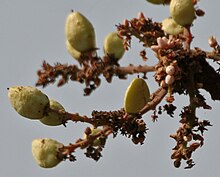Boswellia serrata
| Boswellia serrata | |
|---|---|

| |
| in Kinnerasani Wildlife Sanctuary, Andhra Pradesh, India. | |
| Scientific classification | |
| Kingdom: | Plantae |
| Clade: | Tracheophytes |
| Clade: | Angiosperms |
| Clade: | Eudicots |
| Clade: | Rosids |
| Order: | Sapindales |
| Family: | Burseraceae |
| Genus: | Boswellia |
| Species: | B. serrata
|
| Binomial name | |
| Boswellia serrata | |
Boswellia serrata is a plant that produces Indian frankincense. It is also known as Indian oli-banum, Salai guggul, and Sallaki in Sanskrit.[1] The plant is native to much of India and the Punjab region that extends into Pakistan.[2]
Medical usage
In Ayurvedic medicine, Indian frankincense has been used for hundreds of years for the treatment of arthritis.[3][4]

Extracts of Boswellia serrata have been clinically studied for osteoarthritis and joint function, with the research showing a slight improvement of both pain and function compared to a placebo.[5] Positive effects of Boswellia in some chronic inflammatory diseases including rheumatoid arthritis, bronchial asthma, osteoarthritis, ulcerative colitis and Crohn's disease have been reported.[6] It has been used in Indian traditional medicine for diabetes.[7]
Topical application
Boswellia serrata is used in the manufacture of the anti-wrinkle agent "Boswelox",[8] which has been criticised as being ineffective.[9]
Active constituents
Boswellia serrata contains chemical constituents mainly β-boswellic acid, acetyl-β-boswellic acid, 11-keto-β-boswellic acid and acetyl-11-keto-β-boswellic acid.[10] Acetyl-11-keto-β-boswellic acid (AKBA) is the most potent 5-lipoxygenase enzyme inhibitor which is responsible for inflammation.[11] AKBA is a compound associated with stopping 5-lipoxygenase (5-LOX) inflammation.[12]
References
- ^ Pole, Sebastian (2013) Ayurvedic Medicine: The Principles of Traditional Practice. Singing Dragon Press. p.179
- ^ "Boswellia serrata". Germplasm Resources Information Network. Agricultural Research Service, United States Department of Agriculture. Retrieved 15 October 2014.
- ^ "JOINT RELIEF". www.herbcompanion.com. Retrieved 2009-01-12.
- ^ https://americanindianimports.com/content/9_shallaki-natural-anti-inflammatory
- ^ Cameron, M; Chrubasik, S (May 22, 2014). "Oral herbal therapies for treating osteoarthritis". Cochrane Summaries. Retrieved June 6, 2014.
- ^ Ammon, HP (2010). "Modulation of the immune system by Boswellia serrata extracts and boswellic acids". Phytomedicine. 17 (11): 862–7. doi:10.1016/j.phymed.2010.03.003. PMID 20696559.
- ^ Mehrzadi, S.; Tavakolifar, B.; Huseini, H. F.; Mosavat, S. H.; Heydari, M. (2018). "The Effects of Boswellia serrata Gum Resin on the Blood Glucose and Lipid Profile of Diabetic Patients: A Double-Blind Randomized Placebo-Controlled Clinical Trial". Journal of Evidence-Based Integrative Medicine. 23: 2515690X18772728. doi:10.1177/2515690X18772728. PMC 5960856. PMID 29774768.
- ^ Wrinkle breakthrough claim from L'Oreal
- ^ L'Oreal slammed over cream claims
- ^ Dragos, Dorin; Gilca, Marilena; Gaman, Laura; Vlad, Adelina; Iosif, Liviu; Stoian, Irina; Lupescu, Olivera (2017-01-16). "Phytomedicine in Joint Disorders". Nutrients. 9 (1): 70. doi:10.3390/nu9010070. ISSN 2072-6643. PMC 5295114. PMID 28275210.
{{cite journal}}: CS1 maint: unflagged free DOI (link) - ^ Siddiqui, M. Z. (May 2011). "Boswellia serrata, a potential antiinflammatory agent: an overview 7". Indian Journal of Pharmaceutical Sciences. 73 (3): 255–261. doi:10.4103/0250-474X.93507 (inactive 2018-11-07). PMC 3309643. PMID 22457547.
{{cite journal}}: CS1 maint: DOI inactive as of November 2018 (link) CS1 maint: unflagged free DOI (link) - ^ Meka, B. Z. (Feb 2017). "Synthesis of new analogs of AKBA and evaluation of their anti-inflammatory activities 7". Bioorganic & Medicinal Chemistry. 25 (4): 1374–1388. doi:10.1016/j.bmc.2016.12.045. PMID 28110820.
